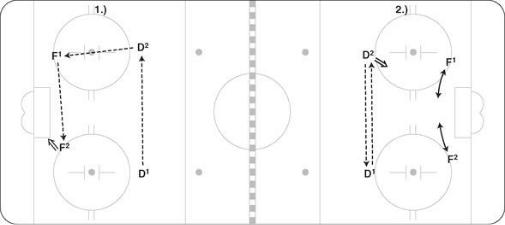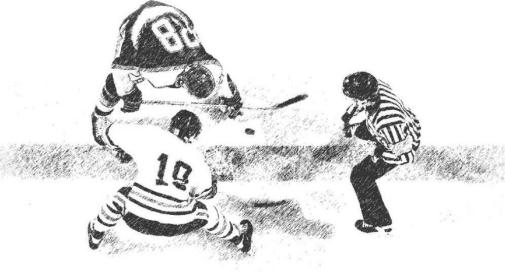
- •Foreword
- •Preface
- •Key to Diagrams
- •Reading Pressure and Options
- •Reacting to Support the Breakout
- •Breakout Plays
- •Control Breakouts
- •Counters
- •Regroups
- •Dump-In Entries
- •Mid-Ice Entries
- •Wide-Lane Drives
- •The Funnel
- •Two-on-One Attacks
- •Two-on-Two Attacks
- •Three-on-Two Attacks
- •Offsides
- •Activating Defense Into Offensive Zone Entries
- •Cycling
- •Playing Behind the Net
- •Stretching the Zone: Low-High Plays
- •Activating Defense in the Offensive Zone
- •Attack Zone Plays
- •Power-Play Breakouts
- •Gaining and Maintaining Possession off the Entry
- •Zone Setup
- •Five-on-Three Power Play
- •Four-on-Three Power Play
- •Forechecking Systems
- •Neutral Zone Forechecking
- •Neutral Zone Forechecking Systems
- •Neutral Zone Backchecking
- •Neutral Zone Backchecking Systems
- •Handling Defensive Zone Entries
- •Defensive Zone Systems
- •Situational Guidelines for Defensive Zone Coverag
- •Face-Offs and Penalty Kills
- •Forechecking and Penalty Kills
- •Pressuring the Entry
- •Defensive Zone Play
- •Three-on-Five Penalty Kill
- •Three-on-Four Penalty Kill
- •Offensive Zone Face-Offs
- •Neutral Zone Face-Offs
- •Defensive Zone Face-Offs
- •Power-Play Face-Offs
- •Penalty-Kill Face-Offs
- •Special Face-Off Situations
- •Managing Staff
- •Dealing With Officials
- •Adjusting Your Playing Strategy
- •Managing Lines
- •Line Changes
- •Handling the Moment
- •Index
- •About the Authors
Four-on-Three Power Play
The four-on-three power play is the least common of the man-advantage opportunities that occur in a game. There are two basic setups: the box and the umbrella. The umbrella is more suited for teams that have a big one-timer shooter up top; the box is better for teams that can make quick, low plays once the shot from the point is taken away.
■ BOX
When using this setup, you need to make sure one of the low players is in a screen position when D1 or D2 shoots. Both forwards and both Ds should be opposite shots. D1 passes to D2, who passes to F1. F1 passes across to F2 for a quick shot (figure 5.29, number 1). D1 and D2 can also pass the puck back and forth, looking for a one-timer (figure 5.29, number 2). Often the penalty killers will overplay the one-timer shots up top and leave a quick two on one low for the forwards.
Figure 5.29

■ UMBRELLA
For this example, D1 is a left shot, D2 is a left shot, and F1 is a right shot. F2 screens in front. Options for the umbrella setup are similar to the five-on-three set-up, with D1, D2, and F1 looking to get a quick one-timer shot. They may move around slightly but generally stay in the high triangle setup. Here are the options: F1 to D1 to D2 for a one-timer; F1 to D1 to D2 and back to F1 for a one-timer (figure 5.30a, number 2); F1 to D1 to D2 and back to D1 for a one-timer (figure 5.30b, number 3); or F1 to D1 to D2 and then low to F2, who can pass to D1 or across to F1 (figure 5.30b, number 4).
Figure 5.30


Part II
Defensive Play for Forwards and Defensemen

Chapter 6
Forechecking
There are basically three situations when a team would apply forechecking pressure. The most common is when a team dumps or chips the puck in from the neutral zone and then tries to retrieve it while the opponent tries to break out. The second is when the offensive team takes a shot that creates a rebound and then they forecheck to get the puck back. The final forechecking situation occurs off a turnover. When the offensive team turns the puck over they now need to apply forechecking pressure to get the puck back. Essentially, there are six keys to successful forechecking pressure:
1.F1 (the first forechecker in) must get in quickly and establish an angle when pursuing the puck carrier. This will limit the options for the breakout team. Taking away time and space from the breakout team forces hurried plays and mistakes. The quicker F1 responds to the puck the less time the offensive team will have to make a play.
2.Once the puck is moved, F1 must recover to a high position above the puck while F2 or F3 responds to pressure the pass. If F1 follows through on the hit he must get off the check right away and move above the circles while observing where the puck is and what is happening.
3.Continue to pressure and recover, pressure and recover until the puck is turned over. The response of the second and third player is key to keep heat on the opposition and force a turnover.
4.If the defensemen are going to pinch (pressure down the boards), they have to get to the puck before it is under control. Pinching defense must read the play and anticipate when the pass is being moved up to the wingers on the boards. One forward must always be in a position to back up the D. Having the high forward in a position to back up the pinching defense will prevent odd-man rushes the other way.
5.Good forecheckers use their sticks to take away passing lanes. Keep it on the ice and in the right lane. The “right lane” is the one that leads to the best breakout option for the other team. Take this option away, or make it difficult to make the pass by having an active stick.
6.Finish hits when appropriate. Physical play on the forecheck often forces the defense to move the puck quicker next time. There are times when a hit is not the best choice. When the forechecker is within striking distance of the pass then continue to pressure the puck
instead of hitting the first opponent.
